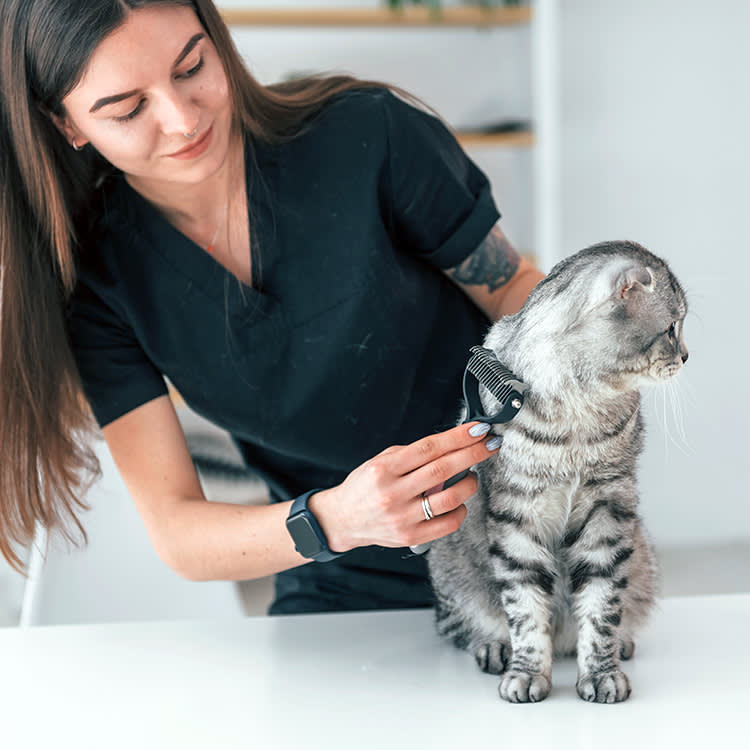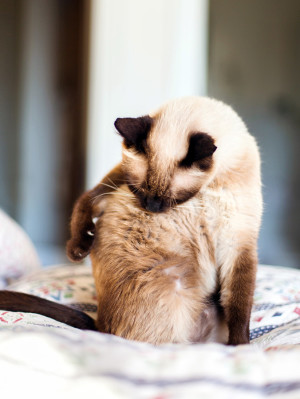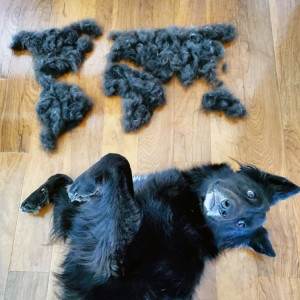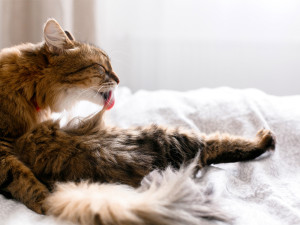How to Safely Remove Matted Cat Hair
With a little patience and technique, you can fix this potentially painful issue.
In This Article:
Why Do Cats Get Matted Fur? Is Matted Hair Painful? Health Risks Associated With Matted Cat Hair Steps to Remove Matted Cat Hair When to See a Professional Cat Groomer How to Prevent Matted Hair
Cats love to look their best, but sometimes, despite their finest grooming efforts, their hair can become painfully tangled and matted. Even though your kitty may not be ready to admit it, removing matted cat hair often takes a helping hand from a pet parent.
Be aware that there’s a right way and a not-as-right way to go about it. With this in mind, let’s look at how to safely remove matted cat hair to get your cat back to looking their best, with as little discomfort as possible.
How much do you spend on your pet per year?
Why do cats get matted fur?
Cats are constantly shedding — replacing old, dead hairs with shiny, new ones. During spring and fall, that shedding kicks up a notch to prepare for a new season’s coat.
As the shed cat fur falls out, it can become entangled in the outer layers, creating snarls or tangles. When severe enough, these tangles can turn to mats, especially if you add a little moisture in there or if it’s in areas of high movement (such as between the legs).
Cat breeds prone to matted hair
Long-haired kitties tend to have more trouble with matting because they have a lot more hair to deal with. We’re looking at you, Ragdolls, Himalayans, and Persians. Ask any human with long hair: It’s typically not a wash-and-go type of hairstyle.
Also, cats who aren’t grooming effectively may have more matting issues because natural grooming habits help prevent mats. Grooming may be downright difficult for cats with arthritis, dental disease, or obesity. Meanwhile, cats with chronic illnesses, such as kidney disease or diabetes, just might not feel like it.
Is matted hair painful for cats?
Nobody likes to have their hair pulled — your cat included — and that’s exactly what a mat does. As the matted hair tightens, it painfully pulls on your cat’s skin. It also creates a lot of heat and irritation, potentially leading to inflamed, itchy skin.
Health risks associated with matted cat hair
Pain and discomfort aside, matted hair can actually lead to some health problems. Remember that irritation and inflammation we mentioned? That itchiness can lead to hot spots, self-inflicted injuries, and skin infections. Cats with matted hair around their anus or genitals can suffer from constipation or urinary tract infections as well.
Steps to remove matted cat hair
Your cat needs your help to get those nasty mats out. But before whipping out your scissors, let’s look into how to safely remove matted cat hair.
Step 1: Gather your tools.
There are actually tools made specifically for detangling mats in cats, but they aren’t the only tools that can work. Consider the following:
Detangling tool
Mat splitter
Other long-toothed combs
A slicker brush
Blunt-tipped scissors (if needed)
Clippers (if needed)
Detangling spray (if needed)
Step 2: Calm your cat.
Your kitty isn’t going to appreciate you going in combs-a-blazing, so be sure to take a slow and steady approach. Start with a little petting and affection. Have a helper, if possible, to offer reassurance while they help to gently hold your cat.
Keep a close eye on your cat’s behavior throughout the process and provide breaks and rewards as needed. The last thing you want to do is work on a wriggling or upset cat, because you could cause an injury or excessive stress.
Step 3: Gently brush around the mat.
You’ll want to pay attention to the area around the mat before taking on the mat itself. Using your slicker brush, start to brush the hair around the mat. This will help detangle hairs around the edges that may be looser.
Step 4: Attack the mat (gently).
Use your mat splitter, detangling tool, or other long-toothed comb to start deconstructing the mat. Gently use the tool to work the outer ends of the hair first, and then work towards the skin. If needed, you can apply some detangling spray, which will help lubricate the hairs for easier untangling.
Step 5: Clip the mat.
Not every mat is going to yield to combs or brushes. These may need to be removed by carefully clipping the hair as close to the mat (and as far from the skin) as possible. Some mats will be tangled so close to the skin that there won’t be room for scissors, so clippers may be the best option.
It’s completely understandable if you’re not comfortable with this step, so don’t be afraid to seek professional help if your cat’s mats need clipping or shaving.
When to see a professional cat groomer for mats
Not every cat parent is going to want to undertake the detangling process themselves, and that’s completely OK. If your cat is especially tangled or has mats close to the skin that can’t be brushed or combed out, a professional groomer may be the best way to go. Not only will they have special tools to help, but they may also have more experience in this area.
If your kitty is already experiencing irritation, inflammation, or worse from the mat, see your veterinarian.
Should a cat be sedated before detangling?
Though you don’t typically need medication before a haircut, sometimes our cats do, especially if they’ve had a negative experience in the past. If your cat is upset about the process — or is such a matted mess that shaving is necessary — sedation may be the best route. Speak to your veterinarian about your options.
How to prevent matted hair in cats
You’ve no doubt heard that prevention is the best medicine. Well, it turns out it’s also the best way to deal with matted cat hair. If you’d rather not deal with brushing or snipping mats, do your best to keep your cat’s haircoat brushed and tangle-free. Though they may spend an inordinate amount of time grooming, get in there and brush them.
Using your preferred brush or comb, work over your cat’s entire body, paying special attention to the hair between their legs, around their neck, and under their tail.
How often should I groom my cat?
Even healthy groomers can benefit from a weekly brushing. Not only will it help prevent mats, but it can also cut down on hairballs and external parasites. Long-haired cats may appreciate a good brushing every couple of days, and be sure to really up your frequency during peak shedding seasons for the best results.
Bottom line
Mats can form on any cat at any time, but they tend to be more common in long-haired cats and during times of heavy shedding.
Regularly brushing your cat can help prevent and remove tangles before they take on the mat form.
If a mat has already set up residence on your cat, get your tools, a little help, and start to gently break down the mat from the outside, working inward. If a mat needs clipping or you’re uncomfortable removing it, see your vet or a professional groomer.
FAQs
Can I bathe my cat to remove mats?
It may be your first instinct to get your cat wet to help loosen mats, but water can actually make mats tighter. Instead, you’ll want to remove mats before bathing your cat by following the above steps or by seeing a veterinarian or groomer.
Should you remove mats from your cat’s hair yourself?
You may be able to remove small, loose mats at home by gently brushing or using a detangling tool or mat splitter. Tougher mats that are close to the skin may require some professional help.
Will a cat’s matted fur grow out?
Unlike our hair, a cat’s hair only grows to a certain length, it doesn’t grow continually. So, if a mat forms in a cat’s hair, it won’t grow out. Instead, it may continue to become tighter and tighter until it becomes very uncomfortable or causes health issues like skin infections.
Why is my cat’s fur matted into lumps?
Mats often form when cat hair gets tangled. It can happen due to moisture, motion, or when a cat doesn’t regularly groom.
How to dissolve matted cat hair?
You won’t be able to dissolve a cat hair-mat. Rather, you want to deconstruct it by detangling the hair, if possible. If it can’t be detangled, carefully removing it with blunt-tipped scissors or clippers may be necessary.
How do you detangle severely matted cat hair?
You can start by trying to brush or comb your cat’s hair around the mat, and then work on the mat itself with a detangling tool or mat splitter. Severe mats may need to be removed with scissors or clippers.









